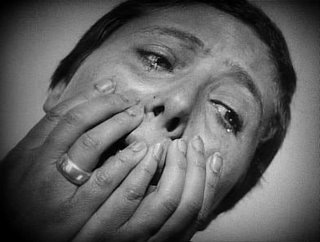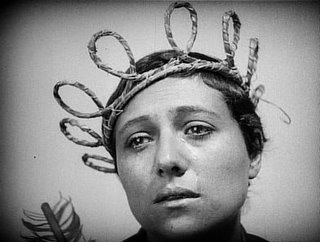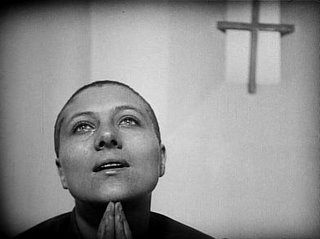The Passion of Joan of Arc
 In the relatively brief history of cinema, there are already a number of treasures presumed lost forever. Carl Theodor Dreyer’s 1928 masterpiece The Passion of Joan of Arc was almost one of them. After the original negative of the film and its replacement were both destroyed by fire, this film existed only in a few differing versions whose murkiness and poor image quality made them all but unwatchable. Such was the lamentable situation until 1981 when a complete original print was discovered in the closet of a Norwegian mental hospital of all places! With this remarkable discovery, it has been possible for a new audience to appreciate this classic film which, although filmed almost 80 years ago, still stands as one of the most profound and engaging works of cinema.
In the relatively brief history of cinema, there are already a number of treasures presumed lost forever. Carl Theodor Dreyer’s 1928 masterpiece The Passion of Joan of Arc was almost one of them. After the original negative of the film and its replacement were both destroyed by fire, this film existed only in a few differing versions whose murkiness and poor image quality made them all but unwatchable. Such was the lamentable situation until 1981 when a complete original print was discovered in the closet of a Norwegian mental hospital of all places! With this remarkable discovery, it has been possible for a new audience to appreciate this classic film which, although filmed almost 80 years ago, still stands as one of the most profound and engaging works of cinema.This film, as you might guess from its title, is about Joan of Arc, the French heroine who, in the 15th century, heard God’s voice and led a surprisingly successful campaign against the British occupiers of French lands. Joan was eventually captured, tried for heresy and burned at the stake when she was 19 years old. Centuries after her death she became the first person to be canonized after being burnt as a heretic.
Dreyer’s film is no grand historical epic of Joan’s conquests, chronicling only her trial and martyrdom. In researching the screenplay, Dreyer read detailed transcripts of Joan’s trial. The vast majority of what is said in the film, by way of intertitles and dialogue cards, is taken verbatim from these transcripts. It was a primary concern of Dreyer that his film be historically accurate.
Being made in the 1920s, this is a silent film. Thankfully, this specific silent film is very accessible to viewers unfamiliar with the genre. However, the language of silent film is different in a few ways from that of contemporary movies. In the first place, because dialogue cannot be used to define a character or performance, the acting must be broader, more exaggerated than in talkies. Through intense facial expression and overt body language emotions and thoughts are communicated without words. The Passion of Joan of Arc is typical of silent films in this respect, but notable for the quality of the performances given.
The actress who plays the title character, Renee Falconetti, is especially brilliant, giving what may be the greatest performance in the history of cinema. Ebert comments that “In a medium without words, where the filmmakers believed that the camera captured the essence of characters through their faces, to see Falconetti in Dreyer’s ‘The Passion of Joan of Arc’ (1928) is to look into eyes that will never leave you.” Dreyer himself comments, “in Falconetti, who plays Joan, I found what I might, with very bold expression, allow myself to call ‘the martyr’s reincarnation.’”
Another obvious characteristic of silent film is its reliance on powerful visuals. Here too, Dreyer’s
 film is typical, presenting a number of stunning images and beautifully constructed scenes more reminiscent of paintings than cinema.
film is typical, presenting a number of stunning images and beautifully constructed scenes more reminiscent of paintings than cinema.Silent films originally were screened with music accompanying the visuals. The Passion of Joan of Arc, in most or all versions now in circulation, can be watched with an accompanying oratorio written just over ten years ago by noted contemporary composer Richard Einhorn. The music, titled “Voices of Light,” is made up of quotations from female medieval mystics and its beauty is perfectly suited to the film.
In many ways, Dreyer’s film is a typical silent movie. And yet, in many more ways it was, and surprisingly still is, a revolutionary bit of filmmaking. To make this movie, Dreyer ordered that an entire castle, small but complete, be made. Yet this is no ordinary building. The set designer used as inspiration illuminated manuscripts from the 15th century, with all of their unique and inconsistent scaling and geometry. Thus, the set resembles surreal art, some sort of medieval Dali with doors and windows out of plumb and no visible right angles.
Not that we see much of the set. The most profound innovation of Dreyer is that he shot most of Joan of Arc in close-up. In an interview, Dreyer once commented that “Nothing in the world can be compared to the human face. It is a land one can never tire of exploring. There is no greater experience in a studio than to witness the expression of a sensitive face under the mysterious power of inspiration. To see it animated from inside, and turning into poetry.” In this film he explores the human face in great detail, aided by new panchromatic film which allowed him to shoot without the use of any makeup. Finally, Dreyer’s direction is remarkable for a few fancy flourishes. Shots are brief, meaning there are many cuts to new camera angles and perspectives. Unusual and striking angles, from above and below the actors, a great deal of camera movement and interesting blocking give The Passion of Joan of Arc a unique and captivating visual style.
And yet, all of this is not style for style’s sake. The close-ups, the quick editing, the camera angles, and the set all add up to make this the most subjective movie ever made. What I mean is that the viewer comes to share Joan’s experience. As you watch, you are disoriented by the bizarre set. Angry faces shout at you from the screen, hurling accusations from every angle. You are unable to place their position relative to Joan’s. Your disorientation grows. All the while Joan’s face is before you, and more and more you come to identify with her in her suffering and martyrdom.
It is for this reason that at this time of Lent, in which we as Christians focus on Christ’s approaching sacrifice, no film is more appropriate than The Passion of Joan of Arc. It is a Lenten feast for the soul. Catholic critic Stephen Greydanus put it best: “The experience of watching this film brings me closer to Good Friday than any filmed depiction of the actual trials and sufferings of Christ to date. I know of movies more theologically profound or more pious, but none more evocative of what it means to share the sufferings of Christ.”


No comments:
Post a Comment